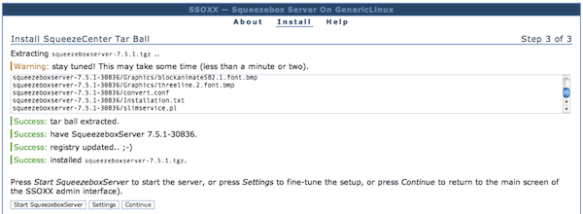Looking for an inexpensive, quiet and low-power Squeezebox Server?
The O2 Joggler is a rebadged version of a OpenPeak OpenFrame 7″ touch-screen device. It has an Intel Atom Z520 CPU running at 1.3Ghz, 512Mb of RAM and 1GB of internal flash storage. You can also run it as a fully functioning Squeezebox Server!
Here’s how:
- First check that your Joggler is running the latest 26635.S3 (Jun 25 2010) software, if it’s not then update
- You will need telnet access, so download this Joggler telnet hack
- Unpack the Zip archive to the root of a USB stick formatted in FAT16 or FAT32
- Unplug the Joggler, insert the USB stick, then power on again and wait!
- When the Joggler reboots it will have telnet enabled 🙂
- Telnet to the IP address of your Joggler and login with the username ‘letmein’
- Download Logitech’s Squeezebox Server v7.5.1 and save to your PC desktop
Now use these commands to download and install flipflip’s Squeezebox server wrapper:
cd /media mkdir /media/ssods4 /opt ln -s /media/ssods4 /opt/ssods4 cd /opt/ssods4 wget http://oinkzwurgl.org/downloads/ssods/ssods-4.9.1-i686.tar.gz tar -xzvpf ssods-4.9.1-i686.tar.gz echo "ssods:*:1000:1000:ssods:/opt/ssods4:" >> /etc/passwd echo "ssods:*:1000:" >> /etc/group LC_ALL= /opt/ssods4/etc/init.d/rc.ssods start
Assuming all the above has gone ok, you can now open a browser and finish the Squeezebox server installation:
- Open a web browser on your PC and enter the URL of your Joggler, e.g. http://192.168.1.65:9099/
- Follow the instructions in SSOXX to upload the squeezeboxserver-7.5.1.tgz file you downloaded earlier and then install the SqueezeCenter tar ball
- When it’s finished you should see Success messages like the screenshot below
- Now just click on ‘Start SqueezeboxServer’ to fire it up

If you are going to use your Joggler as a dedicated Squeezebox Server then you might want to make the following tweaks to ensure that it all starts up automatically and unnecessary processes are disabled:
- Edit /etc/init.d/boot.d/S99boot.hacks and add the line ‘LC_ALL= /opt/ssods4/etc/init.d/rc.ssods start’ in the starthacks() function, just after the telnetd line should be fine (my S99boot.hacks additions are at the end of this post)
- Go into the SSOXX settings tab and make sure that autostart is enabled
- Stop the X11 server and O2 GUI from loading by commenting out the following two lines from the end of /etc/init.d/rcS
cd /openpeak/tango ./run &
- Disable automatic software updating to ensure that all your good work is not undone in the future:
echo "127.0.0.1 localhost applog.openpeak.net o2.openpeak.com o2.openpeak.co.uk" > /etc/hosts
I want to keep my Joggler in a cupboard and forget all about it, so I have no use for the display.
To save power I switch the screen off entirely, to do this I use Starter’s driver patches:
cd /media wget http://get.intanet.com/dl/brightness.sh wget http://get.intanet.com/dl/bp ./brightness.sh allowscreenoff 1 ./brightness.sh negativevalues 1
Add the following line to /etc/init.d/boot.d/S99boot.hacks:
/bin/echo "-3">/proc/blctrl"
If you want to mount a Samba/CIFS share (like a NAS mount) you will need to download the cifs.ko kernel module and add that to the startup file.
The starthacks() function in my /etc/init.d/boot.d/S99boot.hacks startup file now looks like this:
starthacks()
{
# enable telnet
/usr/sbin/telnetd
# load CIFS kernel module
/sbin/insmod /media/cifs.ko
/bin/sleep 2
# mount network share
/bin/mount -t cifs //192.168.1.2/musicshare /mnt/music -o user=music,password=secret
/bin/sleep 2
# disable screen
/bin/echo "-3">/proc/blctrl
# start SSOXX and Squeezebox Server
LC_ALL= /opt/ssods4/etc/init.d/rc.ssods start
}
Reboot your Joggler for the display driver patches to load.